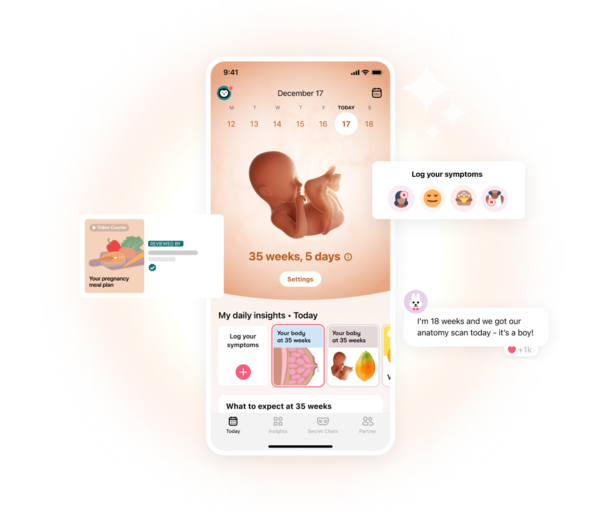During pregnancy, it’s normal to experience pain throughout the body, such as in the lower back, breasts, and abdomen. Vaginal pain, however, typically begins in the second trimester and can occur till delivery. Let’s discuss symptoms, causes, and treatments.
-
Tracking cycle
-
Getting pregnant
-
Pregnancy
-
Help Center
-
Flo for Partners
-
Anonymous Mode
-
Flo app reviews
-
Flo Premium New
-
Secret Chats New
-
Symptom Checker New
-
Your cycle
-
Health 360°
-
Getting pregnant
-
Pregnancy
-
Being a mom
-
LGBTQ+
-
Quizzes
-
Ovulation calculator
-
hCG calculator
-
Pregnancy test calculator
-
Menstrual cycle calculator
-
Period calculator
-
Implantation calculator
-
Pregnancy weeks to months calculator
-
Pregnancy due date calculator
-
IVF and FET due date calculator
-
Due date calculator by ultrasound
-
Medical Affairs
-
Science & Research
-
Pass It On Project New
-
Privacy Portal
-
Press Center
-
Flo Accuracy
-
Careers
-
Contact Us
Vaginal Pain During Pregnancy: Why It Happens and What to Do About It


Every piece of content at Flo Health adheres to the highest editorial standards for language, style, and medical accuracy. To learn what we do to deliver the best health and lifestyle insights to you, check out our content review principles.
Causes of vaginal pain during pregnancy
A growing fetus, dilation of the cervix, increased blood flow to the vagina, and fungal infections can all contribute to vaginal pain during pregnancy.
Growing fetus
As your baby and your uterus grow, your pelvic ligaments stretch to accommodate the extra weight. When ligaments and vaginal muscles are overstretched, it can cause a sharp, shooting pain. If you’re already feeling vaginal pain in the first trimester, though, be sure to consult your doctor.
Dilation of the cervix
Dilation refers to the eventual opening of your cervix. Occasionally, cervical dilation is to blame for sharp, shooting vaginal pains in the final stages of pregnancy. This is a perfectly normal process that helps the body prepare for labor and delivery. But should the pain present in the lower abdomen, consult a doctor right away.
Take a quiz
Find out what you can do with our Health Assistant
During labor, uterine contractions open the cervix while the baby moves into the proper position. Effacement (when the cervix stretches and thins) and dilation allow the baby to pass through the birthing canal. This happens near the end of the third trimester, but varies with each individual. Some people start to efface and dilate over several weeks, and others shortly before the baby is born. First-time moms might not dilate until they’re in actual labor. An OB-GYN may check the cervix manually to monitor progress as part of prenatal care.
Increased blood flow
Increased blood flow to the vagina, accompanied by heavy vaginal discharge, are normal during pregnancy. Higher levels of estrogen and progesterone produce these changes. The increased overall volume of blood can cause vaginal discomfort or pain.
Fungal infections
If you’re experiencing vaginal pain during pregnancy and suspect it’s the result of a fungal infection, talk to your physician. The most common infection is candida (yeast infection), which is common during pregnancy because of compromised immunity.
During pregnancy, recovering from candida might take longer than usual, as healthcare providers hesitate to prescribe cortisone medications. Consider treating it with an OTC antifungal cream or suppositories. Just remember to discuss this with your doctor first.
Lightning pain
Sometimes pain originating in the pelvic ligaments as they stretch to accommodate a baby can cause startling pain. It can be shocking enough to make some people think they’ve gone into labor. This is called lightning pain.
Some women naturally produce more relaxin and progesterone hormones, encouraging extra stretching and loosening of the ligaments. When round ligaments are stretched too quickly, it produces a sensation similar to that of lightning shooting through your crotch.
In certain cases, this does actually signal the start of labor. Constant back or lightning pain, contractions, or fluid leakage are all signs that the baby could be on their way. If you observe any of the above symptoms prior to 37 weeks, seek medical attention.
Ectopic pregnancy
Another potential cause of vaginal pain is ectopic pregnancy. This is when the fertilized egg implants anywhere other than the uterus. Most often, the fertilized egg will attach inside a uterine tube.
Ectopic pregnancies cannot be carried to term. The fertilized egg is unable to survive outside of the uterus. In certain cases, an ectopic pregnancy may cause the uterine tube to rupture, resulting in vaginal pain, bleeding, lightheadedness, and nausea. Seek medical help if you show any signs of ectopic pregnancy.
How to cope with vaginal pain during pregnancy

Vaginal pain occurs at some point during nearly every pregnancy. Besides pain medications (which should be approved by a doctor), there are a few different ways to find temporary relief:
- Lying on the left side to improve blood circulation and reduce vaginal pressure
- Sitting elevated feet, which could also decrease pressure levels and alleviate vaginal pain
- Elevating the hips to lessen cervical pain during pregnancy (which usually aggravates existing vaginal discomfort)
- Taking warm baths to soothe and relax achy muscles throughout the body
- Engaging in activities such as yoga or swimming to help boost blood circulation and strengthen muscles.
- Getting a doctor-approved pelvic massage that can simultaneously offer much needed pelvic support and a reprieve from vaginal pain during pregnancy.
When to see a doctor
Vaginal pain is a normal part of pregnancy for most people. Although a few minor lifestyle changes can help, a doctor is the best source of guidance, especially in later trimesters. You can learn more about this and what else to expect throughout the trimesters with a pregnancy tracking app like Flo.
Additionally, there are various options available for treating vaginal pregnancy pain that you can research. Just remember that certain conditions, like infection or irregularities in the cervix, could potentially lead to miscarriage. That’s why it’s always a good idea to speak with a doctor about any questions, concerns, or possible treatments first.


Hey, I'm Anique
I started using Flo app to track my period and ovulation because we wanted to have a baby.


The Flo app helped me learn about my body and spot ovulation signs during our conception journey.


I vividly
remember the day
that we switched
Flo into
Pregnancy Mode — it was
such a special
moment.
Real stories, real results
Learn how the Flo app became an amazing cheerleader for us on our conception journey.
References
https://www.mottchildren.org/health-library/zx3441
https://my.clevelandclinic.org/health/articles/9676-labor--delivery
https://www.mayoclinic.org/healthy-lifestyle/labor-and-delivery/in-depth/signs-of-labor/art-20046184
https://www.healthline.com/health/vaginal-health/how-pregnancy-affects-vaginal-health
https://www.acog.org/Patients/FAQs/Vulvovaginal-Health?IsMobileSet=false#occur
https://www.ncbi.nlm.nih.gov/pmc/articles/PMC2654841/
History of updates
Current version (18 July 2022)
Published (03 October 2019)
In this article

Get your personal guide to pregnancy with the Flo app
-
Follow your baby's growth week by week
-
Get expert info on symptoms, safe foods, and more
-
Chat with other parents-to-be




